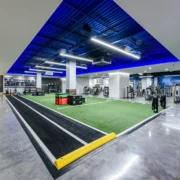Member of the Future: What Do They Expect?

The gym members of tomorrow will be more tech-savvy, sustainability-conscious, and deeply focused on personalization and flexibility. By 2030, fitness enthusiasts will demand experiences that go beyond traditional workout routines, fueled by advancements in wearable technology, artificial intelligence (AI), and global connectivity. Athletech News analyzed the news from the past 10 months and developed the following deeper look at the key preferences and expectations of this future gym-goer:
1. Personalized Fitness Experiences
The future member expects tailored fitness experiences designed specifically to meet their goals. Wearable devices like the Apple Watch, Fitbit and Garmin will provide real-time feedback on everything from heart rate and calorie burn to sleep quality and stress levels. This data will seamlessly integrate with gym equipment and fitness apps to offer highly personalized training sessions.
The member of 2030 will no longer settle for generic workouts; they will expect AI-driven platforms to create custom routines that adjust based on their daily performance, progress, and even health conditions (Corporate Fitness Works); (Wexer).
Example: Companies like Peloton and Ergatta are already leading this shift. Peloton’s classes are tailored to each individual’s progress, while Ergatta’s rowing machine recalibrates workouts based on the user’s performance after every ten sessions, ensuring a continually optimized workout (Orangesoft). This level of personalization is just the beginning, with AI becoming a critical tool in delivering bespoke fitness experiences.
2. Seamless Digital Connectivity
The future gym member will prioritize seamless digital connectivity that allows them to transition effortlessly between in-gym workouts, home fitness routines and virtual training sessions. This omnichannel approach is already gaining momentum, with hybrid fitness models showing 41% growth between 2020 and 2022, and 45% of consumers expected to prefer hybrid options by 2024 (Orangesoft); (Wexer). These members will demand platforms that sync their wearable data with gym equipment and apps, providing them with consistent feedback regardless of their location.
Example: Cyclists and runners use Zwift to train in virtual, game-inspired environments that provide real-time feedback on their performance. This type of immersive experience, paired with data-driven customization, will only become more prevalent as digital fitness solutions evolve (Orangesoft).
3. Eco-Conscious Fitness
Sustainability is rapidly becoming a priority for gym-goers, especially for younger generations like Gen Z and Millennials. By 2030, future gym members will expect eco-conscious facilities that incorporate energy-efficient equipment, sustainable materials, and green operational practices. According to industry reports, the global push for sustainability is influencing fitness equipment design, with companies working to develop machines that reduce energy consumption and carbon footprints (Wexer).
Example: Some companies, like SportsArt, are already developing equipment that converts human energy into usable electricity. Such innovations will likely be in higher demand by 2030 as consumers become more environmentally conscious (Wexer). Future gyms may need to adopt similar practices to remain competitive.
4. Flexibility and Hybrid Training
Future gym members will crave flexibility in their fitness routines, expecting the ability to move between virtual and in-person training seamlessly. As hybrid models continue to grow, more gym-goers will look for fitness experiences that align with their busy lifestyles. Virtual fitness options will become just as important as physical gyms, with members expecting access to live or on-demand classes at the touch of a button (Corporate Fitness Works).
Example: With the rise of connected home gyms like Tonal and Mirror, members can already access studio-quality workouts from home. These hybrid systems will evolve to offer even more flexibility, allowing users to integrate their home workouts with gym sessions, personal training, and group classes (Wexer).
The gym member of the future will expect a fully personalized, connected and eco-friendly fitness experience. Gyms and fitness brands that embrace these expectations—offering real-time data integration, tailored workout plans, and sustainable practices—will thrive in this evolving landscape. As wearable technology, AI and hybrid models continue to develop, the fitness industry will need to remain agile, offering solutions that cater to the needs of tomorrow’s fitness enthusiasts. The future is personalized, connected and green, and the Gym of the Future will reflect these values.
This article original appeared in ATN’s Gym of the Future Report, which explores the technology, equipment and sustainable practices driving a new era of personalized wellness experiences. Download the free report.
References:
Corporate Fitness Works. (2024). Unveiling the Future of Fitness: Insights from the 2024 Connected Health and Fitness Summit. Retrieved from Corporate Fitness Works (Corporate Fitness Works).
Orangesoft. (2024). Connected Fitness Market Trends That Will Completely Take Over 2024. Retrieved from Orangesoft (Orangesoft).
Corporate Fitness Works. (2024). Unveiling the Future of Fitness: Insights from the 2024 Connected Health and Fitness Summit. Retrieved from Corporate Fitness Works (Corporate Fitness Works).
Wellness Creatives. (2024). Fitness Industry Statistics 2024: Market Size & Growth Trends. Retrieved from Wellness Creatives (Wellness Creative Co).Wexer. (2024). 2024 Fitness Industry Trends Driving Growth. Retrieved from Wexer.



